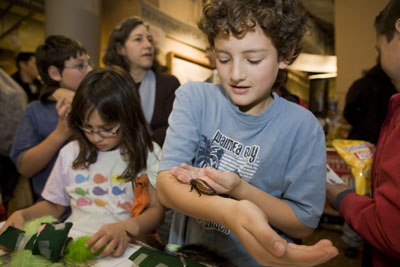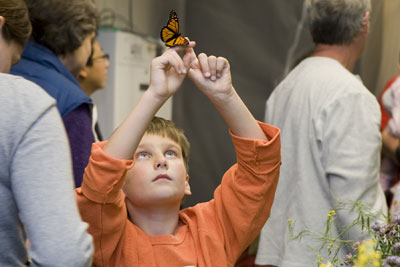Community learns about the wonderful and weird world of creepy crawlers
By Laura Janka


The giant African millipede, with its up to 400 legs, is an exotic animal usually found only in jungles. Yet visitors to Cornell's Insectapalooza in Comstock Hall Oct. 25 were able to get up close and personal with them as well as maggots, cockroaches, butterflies, grasshoppers and tarantulas, among other insects and arachnids.
Several thousand people attended the carnival-esque Insectapalooza to explore the world of creeping, crawling and flying insects. The event not only featured Cornell's insect collection of more than 5 million specimens but also zoo rooms with live specimens, a butterfly room, a ladybug room, cockroach races, face painting, food and prizes. Entomology professors and student volunteers were on hand to run activities and provide information about the world of insects.
"The insect zoo is a really, really important part of Insectapalooza," said volunteer Samuel Ramsey '11. "We're trying to increase awareness that insects are not the scary creatures that they're made out to be consistently in the media." Bigger specimens, like the praying mantis and large stick insect, allowed visitors to see what insects really look like, particularly their segmented bodies and intricate mouthparts.
"I actually did not like insects when I was younger. I was incredibly afraid of them; I had what's called entomophobia, an irrational fear of insects," admitted Ramsey. He overcame this fear, he said, by learning about insects, and hopes that Insectapalooza allows other young children to do the same. "We have a lot of interesting creatures in here that will spark an interest in science, as well as entomology," he said.
Entomology professor John Losey hopes that such programs as Insectapalooza will engage families and community members into scientific research at Cornell. "We have a program called the Lost Ladybug Project, where we encourage kids to go out and look for ladybugs in their own backyards and neighborhoods, and then send us a picture of whatever they find," Losey said. The pictures are compiled into a database and allow researchers to determine where rarer ladybug varieties are living.
In the ladybug room, Losey explained the project while children hunted for various ladybug types in an artificial wooded environment. As in nature, the rare varieties were more difficult to find. In the butterfly room, new this year, visitors were able to see a rainbow of butterflies and learn how their colors are important as defense mechanisms in nature. At the cockroach races, children placed bets on the fastest roach for a chance to win candy.
Event organizer Margarita Lopez-Uribe, an entomology graduate student, said she enjoyed seeing the visitors learn and especially watch the parents become excited about insects with their children.
Laura Janka '09 is a writer intern at the Cornell Chronicle.
Media Contact
Get Cornell news delivered right to your inbox.
Subscribe